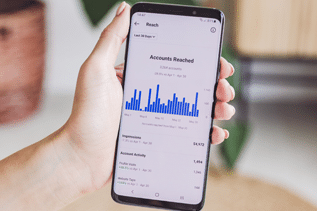
Google SEO Update: October 2022 Roundup
Tags: Google,Updates
Soumi Biswas November 21, 2022 16 MIN READ

October is known for Halloween. Whether Google had ‘Tricks or Treats’ in store for marketing professionals can only be understood after one goes through the October SEO News Recap. The news roundup will offer the latest Google SEO update that can help businesses get a competitive edge over others.
SEO News Recap
What is the latest Google SEO update? Or why should you be concerned about the Google SEO update?
The SEO industry is in a state of flux, and they are bringing various changes that marketers should be aware of.
This is because the SEO landscape is constantly changing its way of ranking websites. For the month of October, Google brought forward some interesting developments. In this blog post, you will get a complete list of the Google SEO updates that might have missed your eye.
What happened in the world of SEO during October? What changes or updates came into effect from October 1 to October 31 that one should remain aware of? These are some questions that might come to your mind if you are associated with the SEO industry.
To know the latest Google SEO updates, let us dig into the details.
1. BrightonSEO – SEO Conference Took Place
For those who missed the BrightonSEO Conference that took place from October 6-7, there is nothing to be disappointed about.
The search marketing conference consisted of in-depth talks from industry experts. Some of the session talks were from the next-gen SEO superstars, who threw light on several things.
Let us see what some superstars had to say during BrightonSEO Conference.
1.1. Luke Carthy on Faceted Navigation
For instance, Luke Carthy’s talk on faceted navigation addressed some of the key issues faced by SEO professionals. It also included some tips on rolling out the faceted search successfully.
Three of the key issues triggered by faceted navigation are URL bloat, potential crawl issues for search engines, and thinning out the equity running through the website.
Facets should go with the categories by adding granularity to those that do not need to be split further. These facets and categories should not overlap as it will trigger cannibalization, which is already a big issue with faceted navigation.
Luke even explained three rules that need to be followed when using facets. They are:
- All indexed filters should have search demand
- Create an ‘Allow’ list of filters that can be indexed
- Use of logic rules for the non-indexing page once it contains a certain number of selected facets
- Only one option per filter is to be indexed
- Nofollow all ‘sort options’ and ‘number of products per page’ options
In this regard, Luke pointed out that a site like Next UK is a good example of faceted navigation since it follows the rules and even avoids the issues covered.
1.2. Chima Mmmeje on On-Page Optimization
Other SEO professionals like Chima Mmmeje offered insight about on-page optimization lessons, such as analyzing 400 blog posts. He reviewed the key concepts of a good blog post, which includes having a structured subheading.
Chima nudged on using offer-related language within the titles, like ‘free templates.’ The key is to get clicks apart from SERP (Search Engine Results Pages) rankings.
1.3. Martin Splitt on Guided Tour of JavaScript for SEO
Another professional, Martin Splitt, offered a brief outlook on how SEO (Search Engine Optimization) can influence HTML by using JavaScript. Martin pointed out that anything within the DOM gets reflected on the page; however, as SEOs, one should not look at visible elements only. This is especially important when there is a need to measure the impact of elements, such as infinite scroll.
Hence, BrightonSEO offered many interactive sessions on SEO and even content strategy, which is a part of SEO.
2. Spike in the Suspension of Google Business Profiles
At the beginning of October, a few spikes in the suspension of Google Business Profiles were seen. Barry Schwartz noticed some noteworthy suspensions during the first couple of weeks in October.
Basically, greater than usual levels of Google Business Profiles were suspended on Google Maps. In fact, the profiles were removed completely from the search results. Many users stated that their profiles after creating a post had been suspended since they updated their Google Business Profiles.
Similarly, in the local search forum, another user even mentioned that changing the category of their business profile also triggered profile suspension. The user further stated that Google does not want any kind of change in the business profile after it is verified.

3. Google Asks Experts to Ignore Things That Talk About Link Juice
A user asked Muller whether link juice gets lost with outbound links. Also, when articles get good outbound links for reference, does it increase the trustworthiness of those articles?
John Muller from Google stated that anything related to the link juice discussed on the web must be ignored. He stated that creating beautiful sites with useful, as well as inspirational content for people is more crucial.
4. Important October 2022 Spam Update
In October, Google confirmed an algorithm update rollout that aims to fight spam. The company stated that the update would impact all languages.
Google did not offer any confirmed date for the spam update rollout, nor did they offer any specific details of the update. Only in rare cases, like when a spam update is going to target a specific type of spam, will Google offer details.
On 1October 19, Google finally started to roll out the spam update. The spam update helps to maintain the search results quality. In other words, spam updates are designed for improving Google’s automated system which constantly runs in the background for spotting spam in the search results.
Industry professionals pointed out that the earlier spam update took place in November 2021, and it took around 8 days to roll out. However, other spam updates took just 24 hours to roll out.
4.1. Is There Any Need to be Worried About Spam Updates?
On closely following the Google Search Essentials, previously known as the Google Webmaster Guidelines, then it is evident that there is nothing much to be worried about with this October spam update.
Usually, spam updates aim to target phishing scams and other digital deviants of the web that try to rank in the search results by presenting themselves as highly relevant pages.
Often web pages with thin content that adds little value will be considered spammy as they do not meet Google’s spam definition. Thin content gets more hits by Google’s helpful content algorithm. In case you do not have any idea about the definition of spam as per Google, reviewing the new Google Search Essentials is important.
4.2. The Result of Spam Updates
If you notice any significant changes in organic traffic or in rankings, you must look at Google’s spam policies. The policy will help you to understand why your site is ranking low or not appearing in the search results.
When a site is hit by a spam update, the content of the site is either relegated or removed from Google’s index.
As per Google, it might take several months to recover from the negative impact of the update, on condition that the website makes the required changes for complying with Google’s spam policies.

5. Google Algorithm Update
On October 13, some of the top-ranking tools started noticing some significant twitching that pointed towards Google rolling out some latest updates.
However, Google eventually confirmed that the October 2022 spam update finished its rollout on the morning of October 21. The online communities and rank tracking tools hinted or pointed out the nature of the spam updates; there was nothing surprising.
But on October 22, the online SEO communities were concerned about the last update and started discussing it. Similarly, major swings were seen in the rank tracking tools that indicated a major Google SEO update was in progress.
6. New Google Ranking Update is Responsible for Rank Swings
If you are looking for some interesting Google SEO updates, then this news is something great for you. In early October, a new Google ranking update was seen. The result of the latest Google SEO update was a massive swing in Google’s ranking.
Glenn Gabe on Twitter observed that certain sites are facing ranking swings. This swing hints that Google’s machine learning models are having a tough time figuring out a site. He also pointed out that some sites faced a drop and surged back during major updates, such as various Product Review Updates (PRU).
Again, the same sites, during the September PRU plummeted. So, it can be said that with every major algorithm update, the sites drop and surge. This shows clearly that it is becoming hard to understand the sites by the algorithms.
7. Webmaster Guidelines are Search Engine Essentials
Finally, Google refreshed its Webmaster Guidelines. For SEO industry professionals, this is important Google SEO news. Just like any Google SEO update is important for SEO professionals; similarly, the news of Webmaster Guidelines being named Google Search Essentials is very crucial.
In many cases, the guidelines have been simplified and clarified. By ‘essentials’ Google tries to be more specific. Now it covers spam policies, technical requirements, and some of the best practices. Starting from webmasters to site owners to SEO professionals who want a site to perform well on Google Search, all should go through the Google Search Essentials.
8. Changing URLs for SEO Purposes is Unnecessary
Another interesting piece of news is changing the URLs for SEO’s sake is a risky step or bet. As a matter of fact, it might have an impact on the ranking. When the URL is getting changed, a redirect needs to be added.
From an earlier Google SEO update we know well that Google takes time to crawl and process these changes. Hence, the position from Google’s results pages might plummet. John Muller of Google pointed out that changing the URLs does not affect the ranking positively. Hence, changing URLs is not worth it.

9. Product Review Update
Early in October, Danny Sullivan on Twitter explained that the product review update works well on the page level. However, Google does act against it.
Danny reiterated that when a site contains a lot of product review content, Google will act against it. Danny Sullivan made this comment when most people showed concern about the product review update and the right way to apply it to sites.
Some other Google SEO update is that structured data will be helping Google to understand that the page is a product review page. However, structured data is not going to be a deciding factor for ranking.
Moreover, Google just updated its new documentation on writing high-quality product reviews. They even specified who could write product reviews.
9.1. Who Can Offer Reviews
According to Google, expert staff members, editorial staff of news and publishing sites, and bloggers can provide opinions about products.
10. Having Empty ALT Text is Fine
Another new Google SEO update from the Search Off the Record podcast is that decorative images that do not add any content to a page will not require any alt text. Google’s John Muller affirmed the statement.
A Twitter user expressed concerns over the accessibility issues of not having alt text in images. To this, Dr. Marie Haynes replied that it is applicable for decorative images only.

11. Site Names in Mobile Results
On October 14, Google made some significant changes to mobile search results. Of late, Google has been tweaking the way meta-data is displayed in mobile search results. For instance, if you are searching for a certain website, Google is comprehending that users will know what they are expecting from the site; hence, rather than showing the full title tag, it will display the name of the site.
This feature is going to help users to navigate to the right website. From this Google SEO update, it is evident that fewer texts will be displayed in the search results.
The site names will be shown above the URL when searches are made in English, French, German, and Japanese. Presently, this feature is available only for mobile devices. Also, this feature is supported only for the domain level.
In fact, Google is recommending all sites have a ‘WebSite Structured Data’ for the root URL on the domain. This will help Google understand the website name or its alternatives.
12. Big Announcements from Google’s Search on 22
What seemed to be an obvious expansion of its use of Multitask Unified Model, at Google’s Search On 22 events, many new features were announced. Some of them are presently available or might be made available soon in Search, especially for the iOS app.
Some of the exciting advancements are:
12.1. Expansion of Multisearch
Apart from using the phone’s camera for searching in Google Lens, text can be added to the query for narrowing down the results. For instance, ‘near me’ query additions are going to be introduced for multiasearch soon.
12.2. Shortcuts to the iOS App
Right under the search bar in the Google app, there are some buttons for product shopping, searching from an image in the phone’s camera roll, translating text, identifying a song, and more.
12.3. Translated News
Whether a user is searching for local or global news, now they will be able to find it from the original sources. The news will be translated into English through Google translate. This, in turn, will allow users to view an ‘authoritative view from journalists,’ i.e., right from the place of occurrence.
12.4. Visual Elements in Search Results
For an increasing number of queries, Google is offering more images and videos in the search results, which include tips, things to do, and even visual stories.
13. SERP Updates
We cannot miss any SERP update, which is a part of the Google SEO update. For SERP news, Google started showing a new User Interface (UI) for mobile, which also includes the relabeled ‘Ads’ to ‘Sponsored.’
14. Google Shopping Is Going to Become More Visual for Desktop
You heard that right! Google shopping functionality has gone through an overhaul to make it even more appealing to consumers. Google Shopping Ads or Product Listing Ads have been coming up in the SERPs (Search Engine Results Pages) for quite some time; however, retailers can now have their product listings pulled through the organic search results. Indeed, this will allow potential customers to view the products without visiting the site.

15. Google Analytics Brings Back Query Data
If you are looking for the latest Google SEO updates, you should not miss this news. Earlier in October, a bug appeared in which Universal Analytics lost all their data starting October 1.
By October 27, all issues were fixed, and Google replaced the back data. John Muller from Google confirmed the news and stated that his team was working to resolve the issue.
16. Tell Googlebot About New Content
An important Google SEO update for webmasters is that they should let Googlebot know about new pages that are added to the sitemap.
According to Mullers, if site owners want to get new content indexed quickly, then it is important to include a link to the XML sitemap file in the robots.txt file. At the same time, the ping tool must be used to tell Googlebot about the new pages.
17. Temporarily Taking Website Offline
Another interesting new Google SEO update is that webmasters or site owners can now use a 503-status code to inform Googlebot about any site being temporarily unavailable. However, site owners must ensure to remove the 503 as quickly as possible. The 503-status code can be used for a maximum of one day.
In case any top pages of the website get removed from the SERPs, make sure to search it in the Search Console and request for indexing. Here, one should remember that Google will not be indexing all pages. Hence, a judicious request must be made.

18. Google Business Profile Insights Traffic Saw an Odd Spike
Another interesting Google SEO update for the month of October is the spike in traffic to the Google Business Profile Insights reporting platform. Basically, the data hinted towards a huge spike in traffic that was unaccounted for.
The two products for which these spikes were seen included Google Maps and Google Local. The matter was raised on localsearchforum, and the spike was seen in the auto dealership industry.
19. Google Business Profile Rolling Out Web Search Menu
Early this year, it was reported that Google was testing an expanded menu for managing the Google Business Profile in Google Web Search.
In the month of October, Google finally rolled out the expanded menu.
This will allow business owners to quickly edit their business profile directly in the web search with the help of new action buttons.
To put it simply, this is going to be a new way to update and improve the business listings within SERPs. Some of the action buttons are:
- Adding a photo
- Booking
- Calls
- Edit profile
- Messages
- Reading a review
- Advertising
- Adding updates
The list goes on. So, managing Google Business Profile will be easy. Missing out on such an important Google SEO update would have been your loss.
20. Google Search Ranking Update
Around October 13, an unconfirmed Google update was reported. Even some ranking tools signaled a major update taking place. But still, Google did not confirm the news. Some SEO professionals discussed some major shifts in ranking that resulted in their sites facing some issues.
21. Human Written Content is Not Necessary
Due to the Google spam update, a lot of human-written content got punished. John Muller was asked on Twitter about human-written content and the way it is related to the new Google spam update.
Muller stated that just because the content is written by a human does not mean that the content is good and helpful. He even restated that setting a low bar for technically okay content and anticipating satisfactory results in Google SERPs is not a good idea.
Are All These Updates for the Good?
These are some essential Google SEO updates for any SEO professionals. However, among these important announcements and news, an SEO professional on Twitter mentioned that one of his sites was badly impacted by the spam update.
He even stated his site was not using AI (Artificial Intelligence) content. nor was his site meant for monetization purposes. The SEO professional also stated that the content of his site was scrapped PAA content. So, the Product Review Update for his website proved to cause problems.
On the other hand, other Google SEO updates and news roundups are for the good of the industry. Following the latest Google SEO updates, some businesses have greatly benefitted.

Google Updates: How to Survive Them?
Imagine the scenario. You run an eCommerce business. You have a website for representing your business in front of the world. So, your site not only acts as a source of revenue, but also acts as the face of your brand to pull customers from across the globe. To remain on top of the SERPs, you will need to optimize the site. As needed, you are optimizing the site and enjoying the top spot in SERPs.
However, one day you find you are not in the top spot. Rather, your position has dipped significantly and even traffic has plummeted. You find your competitor is enjoying the top spot. The feeling can’t be described in words.
So, what happened really? You might want to know the reason for the same. The answer is Google SEO updates. Any significant Google algorithm update will rock the ranking of a site. Maybe you were not prepared or expecting any such algorithm updates or changes to happen. Hence, the consequence was your site’s rank plummeting.
This is when one needs to remain aware of the latest SEO industry trends. So, remaining prepared for any such new Google SEO update is very crucial for businesses. To remain aware of such significant updates, they can follow the SEO news and blog posts that cover a wide range of topics.
Moreover, you should take the help of professional SEO experts to recover your ranking. They can help to regain traffic which is vital for the ranking.
In the remainder of this blog post, let us take you through the step-by-step process through which you can easily survive such scenarios.
1. Google Updates: What are They?
Google updates are basically changes brought to the Google algorithms. The algorithm is known to guide the rankings of search engines. The update is designed to offer better and even more pertinent information for the end users.
During the update, things that are usually changed are:
- How Google interprets the user intent
- How information gets presented on screen
- How site content gets analyzed and delivered to users
Based on the scale and content of the Google update, a site’s organic performance can be significantly impacted. Or, depending on the update nature and the way it relates to the site content, it might not have any impact at all.
2. How Often Does Google Bring Updates
Before you go through any Google SEO update, make sure to know about the exact frequency of such updates. Basically, Google makes some minor tweaks to its algorithms every day. According to Gary Illyes from Google, on average, 3 updates per day take place.
According to Search Engine Land, Google changed its algorithms 12 times per day in 2022. Often, these updates are technical and might be unique for some regions or for some types of websites or languages. Most of the time, it even remains unnoticed by SEO experts.
However, Google releases a broad core update sometimes. The core updates focus on improving the overall services of Google. This often results in big fluctuations in the search rankings.
3. How to Stay on Top of Google Algorithm Changes
Usually, Google alerts users about Google SEO updates that are upcoming or in line for a certain month through their official channels, like Twitter. In case any minor update is confirmed by Google, then Google also takes the responsibility to offer guidance on the way to respond to such updates.
On the other hand, for any large-scale Google SEO updates or broad core algorithm updates, then one will need to pay close attention to the data of their website. Also, one should track the performance of their competitors and closely listen to the SEO community and forums sharing insights into Google’s activity.
4. How to Recover from a Google Algorithm Update
Wondering how to recover your website from a Google update?
The steps will vary from case to case. It will be based on your site and the nature of the update in question.
If Google releases an update about product listings and you do not deal with such products, then you have nothing much to do with such updates.
On the contrary, if you own an eCommerce business and Google releases product listing updates, then as eCommerce store owners you have a lot of things in hand.
Basically, a site can improve or even recover from such updates by following some basic processes. They are:
- Research the update
- Create an action plan
- Strategically update the content
Now let us go through the updates in detail.
4.1. Start Researching
Before implementing the Google SEO update to a site, you need to know about a few things. They are:
- Was there indeed an update? Or is there any explanation?
- If there was a Google update, then what is the goal?
- Which content got affected due to the Google SEO update?
4.1.1. Was there indeed an update?
First, you need to know if any update took place or not. In most cases, people come to know about Google SEO updates that are in place only after they see any drastic change in website performance or simply when they hear from the SEO community on forums.
But it takes time to confirm such updates. This is because a performance comparison is carried out with more general trends. In the event of a legitimate update, a site will be greatly impacted.
Often with tools like Semrush Sensor, SERP volatility can be tracked.
The volatility score can indicate the number of times changes occurred when compared to a typical period. For instance, if the score is higher than the usual number, then this could hint at an update.
It is also important to filter by device type, region, or category to check a narrow update that only can affect some sites. In the event you do not see any signs but witness a notable change in ranking out of nowhere, then you must search for the cause.
However, if all signs indicate yes, then you will need to proceed to the next question, i.e., what is the goal of the update?
4.1.2. What is the goal of the update?
The goal of any SEO professional or content creator or site owner is not only to please the search engine algorithms, but also to connect with the right audience.
The aim of every Google algorithm update remains the same. Each update is intended to help users find the best possible information in a more effective manner.
However, it is important to determine the definite goal of a certain update, provided one wants to recover traffic.
Sometimes Google confirms such Google SEO updates, such as the Helpful Content Update or the anti-spam update through their official channel on Twitter.
However, one can also learn about the latest Google SEO update from digital publications, such as Search Engine Land or Search Engine Journal.
Also, it is easy to ascertain the goal of any update through context clues. For instance, you can analyze the search results page with tools like Keyword Overview.
4.1.2.1. Things to Look for When Analyzing Result Pages
When analyzing the result pages, just investigate the following things:
- SERP
- Intent
- Variations, questions, and related keywords
SERP: It will tell what information or resources Google thinks users look for during the search.
Intent: The rationale behind the search, which could be navigational, informational, transactional, or even commercial.
Variations, questions, and related keywords: It tells what users are looking for and how they are trying to find it.
By analyzing each of these elements, it is easy to understand how the search page tries to help the users in finding certain things. These findings can be used for content updates.
Also, there is a need to analyze the successful pages. The pages that are highly successful after the update are the ones that align with the update goal.
So, analyzing several top-ranking pages in a single search is always the best bet. It will help to identify the patterns across the most successful results and apply the findings to improve the ranking.
4.1.2.2. Helpful Tools to Use
The Keyword Overview helps to find which pages performed well. One can enter the keyword that was probably impacted by the update.
The SERP Analysis widget not only points out who is ranking, but also shows their contributing factors for the rank, such as their backlink profile, number of keywords, authority score, and search traffic.
Also, by clicking on the ranking page in the widget, overall performance can be analyzed in the Organic Research tool.
The tool even helps to identify the keywords that have gained or lost and the way they are contributing to the traffic.
Finally, take note of the content type, how it has been formatted, and other details of the page you are analyzing. The insights help analyze your site’s content.
4.1.3. Which content was affected due to the Google SEO update?
Once you are aware of the update and what the update is about, the next thing that you will need to do is to identify the pages that were affected by the update.
You will need to check two things. They are:
- Which pages dropped?
- Which pages improved after the update?
With Semrush Position Tracking tool, it is easy to identify the pages affected by using the Pages report. Make sure to note the pages that were affected or have lost keywords. Also, take note of those pages that improved with new keywords. With insights from pages that dropped or improved, an action plan needs to be created.
4.2. Step 2: Create a Plan of Action
Once you have confirmed that there was indeed an update and learned about the goals that drove the update, then it is time to revamp every page of your site.
It is better to plan the steps strategically. First, review the facts that you know. For instance, review the update that Google made and its goal. Second, analyze the way in which it affected the site and its pattern and so on.
Based on the available information, one can develop a strategy and prioritize the most effective updates. Basically, based on the observations, changes can be made to make the content better.
4.2.1. Prioritize Work
As part of this second step, you will need to prioritize your work. Just identify the pages that are crucial to update. In simple words, identify pages that can make a bigger impact. This, in turn, will help to reach results more quickly.
First, consider the pages that are the biggest contributors to reaching the goal. It will vary based on the business you are running. For instance, you can focus on the landing pages that have a high conversion rate or content that is providing support to the sales team.
Once all the data is compiled, flag the pages that were negatively impacted by the Google SEO update. These are high-priority pages.
At the same time, it is important to make a prioritization list that will guide users through the update process.
Here, all easy-win updates can be made a part of the prioritization list. One should also start working on the complex updates and slowly move to high-priority pages.
Meanwhile, it is better to start working on the easy-win updates and low-priority pages. Usually, this plan can guide you through the steps needed for updating the site.

4.3. Step 3: Strategically Update the Site
Once you have a clear picture of the things you need to recover your site and ways to approach it, the only thing left to do is to implement those updates.
Based on the way the site is set up, Google SEO updates can be implemented in a jiffy, or it might take a long time. In case you are not sure of the way, you can do a few things.
- First, have access to pages you want to update via a content management system.
- Second, wait for the developer to implement the changes in the backend.
However, the best way out is to install the Google Chrome extensions and insert a simple code snippet on the <header> tag of the page that needs to be edited.
With the help of PageImprove, all easy-win updates can be made quickly. For instance, the tool might help to update the meta tags, add alt text to images, and more.
It is important to keep in mind that even the simplest Google SEO update will have a significant impact on a site’s ranking. So, working on the updates right from the start is important. This will help sites to deliver the desired results.
Stay Updated with Professional Help
Just like any other month, October was also a bumpy one for the SEO industry. Product review updates and spam updates alike came into effect and resulted in algorithm losses for webmasters.
So, if you don’t want your site’s rank to plummet, stay up to date with Google SEO update roundups from professionals like eWay Corp.
Final Thoughts
Google is trying to make life much easier for its users with frequent updates. It is time to remain aware of the latest and most important October news updates for the SEO industry.
This industry relies on the latest trends and Google SEO updates to maintain a competitive edge. Indeed, October was full of treats for the SEO industry.



